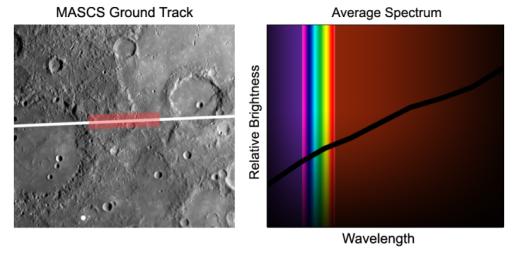
|
First MESSENGER Spectrum of Mercury
- Click the image above for a larger view
- Full-Res JPEG (973 x 480) (57.3 kB)
- Full-Res TIFF (973 x 480) (1.4 MB)
Caption:
During its flyby of Mercury, the MESSENGER spacecraft acquired the first high-resolution spectra of the planet's surface in ultraviolet, visible, and near-infrared light. The image on the left shows a portion of the ground-track along which the Mercury Atmospheric and Surface Composition Spectrometer (MASCS) instrument accumulated over 650 observations of the surface. The depicted area is about 300 kilometers (190 miles) across. The white track covers about 60 of the MASCS "footprints" or spectral snapshots. The red area highlights about 20 footprints averaged to make the example spectrum on the right, showing the relative amount of sunlight reflected from the surface at wavelengths from the ultraviolet to the visible (rainbow) to the infrared. The observations were taken on January 14, 2008, beginning as the spectrometer's field of view crossed into the day-lit side of the planet at a distance of about 1,900 kilometers (about 1,200 miles), and continuing until the field of view left the planet at a distance of about 8,500 kilometers (about 5,300 miles) from Mercury. Mercury is about 4880 kilometers (about 3030 miles) in diameter, and the footprints shown here are about 1 by 5 kilometers (0.6 by 3.4 miles).
The Mercury spectrum shows the degree to which different wavelengths of sunlight are absorbed or reflected by its surface materials. Dips in the spectrum indicate where sunlight shining on the surface is partially absorbed. The absorption bands' sizes and colors are diagnostic of the minerals in surface rocks. While Mercury has been observed telescopically from Earth for centuries, and Mariner 10 took images in one ultraviolet and two color filters when it flew by in 1974 and 1975, MESSENGER is the first mission to observe the surface with enough spatial and spectral resolution to determine Mercury's surface composition.
Background Info:
These images are from MESSENGER, a NASA Discovery mission to conduct the first orbital study of the innermost planet, Mercury. For information regarding the use of images, see the MESSENGER image use policy .
Cataloging Keywords:
| Name | Value | Additional Values |
|---|---|---|
| Target | Mercury | |
| System | ||
| Target Type | Planet | |
| Mission | MESSENGER | Mariner |
| Instrument Host | MESSENGER | Mariner 10 |
| Host Type | Orbiter | Flyby Spacecraft |
| Instrument | Mercury Atmospheric and Surface Composition Spectrometer (MASCS) | |
| Detector | ||
| Extra Keywords | Atmosphere, Color, Infrared, Ultraviolet | |
| Acquisition Date | ||
| Release Date | 2008-01-22 | |
| Date in Caption | 2008-01-14 | |
| Image Credit | NASA/Johns Hopkins University Applied Physics Laboratory/Carnegie Institution of Washington | |
| Source | photojournal.jpl.nasa.gov/catalog/PIA10188 | |
| Identifier | PIA10188 | |
